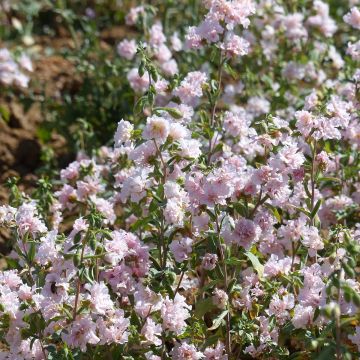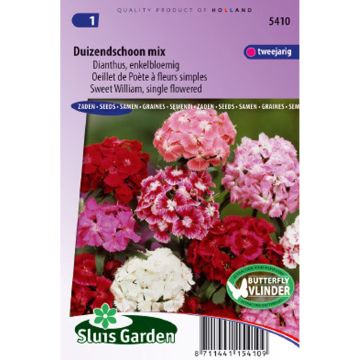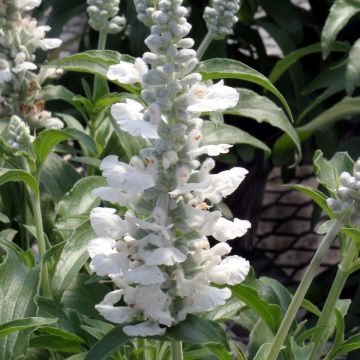

Colossus Marigold Seeds - Tagetes patula
Colossus Marigold Seeds - Tagetes patula
Tagetes patula Colossus
French marigold
Good yield Resilient Very good taste and adds color to the plate I recommend
rose-helene G., 20/01/2017
This plant carries a 6 months recovery warranty
More information
We guarantee the quality of our plants for a full growing cycle, and will replace at our expense any plant that fails to recover under normal climatic and planting conditions.
Seed-only orders are dispatched by sealed envelope. The delivery charge for seed-only orders is €3.90.

Does this plant fit my garden?
Set up your Plantfit profile →
Description
Tagetes patula Colossus, also known as French marigold or spreading Colossus marigold, is one of the most spectacular and easiest flowers to grow. Its flowering extends throughout the summer, until the first frost, offering enormous heads that are fully double and variegated with golden yellow and mahogany red. Early, floriferous, and foolproof, this already ancient variety continues to be a great success. It is ideal for borders or pots, and will thrive in all gardens, from the simplest to the most elaborate. It should be grown in well-drained soil, in full sun or partial shade.
Tagetes patula is an herbaceous annual plant of the aster family, native to tropical regions of the Americas, from Mexico to Bolivia. The plants in the 'Bonita Mixed' selection quickly form small bushy clumps with a spreading habit, reaching 30 cm (12in) in height and 40 cm (16in) in width. They are covered with dark green, highly divided, pinnate foliage that is strongly aromatic, which some people may find unpleasant. The flowering period extends from July to October, with regular deadheading of faded flowers. The plants produce magnificent double heads of flowers, of a good size (approximately 7-8 cm (3in)), with slightly ruffled ligulate petals (the flowers located at the periphery of the head, well developed) that are perfectly arranged. They come in solid or variegated colours, in a range of bright yellow, orange, bronze and copper. This plant readily self-seeds in the garden, but not always true to the original variety.
Marigolds are star plants in summer borders. They are sometimes criticised for their garish colours and neat habit, but they are so cheerful, easy to grow and floriferous that it would be a shame not to enjoy them in borders and containers. They can be scattered among the grey foliage of artemisias and stachys, or surrounded by greenery, paired with tansies, Kochia Childsii, or small grasses that will temper their flamboyant colours. Marigold is also an edible flower that can be enjoyed in salads, soups or desserts. Some say that its flavour resembles that of passion fruit.
The scent of marigold foliage, and the substances secreted by their roots, repel certain pests, which is why these plants are often placed among the vegetables in the vegetable garden.
Report an error about the product description
Flowering
Foliage
Plant habit
Botanical data
Tagetes
patula
Colossus
Asteraceae
French marigold
Cultivar or hybrid
Other Thompson and Morgan seeds
Planting and care
Sowing:
Sow from February to April.
Sow on the surface of a specific sowing compost, moist and well-draining. Cover the seeds with a very thin layer of vermiculite or compost. Place in a mini greenhouse or enclose them in a polyethylene bag at a constant temperature of 20 to 25°C (20 o 77°F) until germination, which usually takes 7 to 21 days. Do not deprive them of light, as this promotes germination.
When the young plants are developed enough to be handled, transplant them into a tray or 8 cm (3in) pots. Acclimatise them to cooler conditions for 10 to 15 days before watering and planting them outside, 15-20 cm (6-8in) apart, as soon as frost is no longer a concern.
Growth:
These fast-growing plants thrive in the sun and in warm conditions. Plant them in fertile, well-drained, light soil. Avoid excessive watering in summer, as this promotes the development of fungal diseases and root rot. Regularly remove faded flowers to prolong the flowering period. Protect the plants from slugs and snails, which are fond of them.
Sowing period
Intended location
-
, onOrder confirmed
Reply from on Promesse de fleurs
Flower seeds
Haven't found what you were looking for?
Hardiness is the lowest winter temperature a plant can endure without suffering serious damage or even dying. However, hardiness is affected by location (a sheltered area, such as a patio), protection (winter cover) and soil type (hardiness is improved by well-drained soil).

Photo Sharing Terms & Conditions
In order to encourage gardeners to interact and share their experiences, Promesse de fleurs offers various media enabling content to be uploaded onto its Site - in particular via the ‘Photo sharing’ module.
The User agrees to refrain from:
- Posting any content that is illegal, prejudicial, insulting, racist, inciteful to hatred, revisionist, contrary to public decency, that infringes on privacy or on the privacy rights of third parties, in particular the publicity rights of persons and goods, intellectual property rights, or the right to privacy.
- Submitting content on behalf of a third party;
- Impersonate the identity of a third party and/or publish any personal information about a third party;
In general, the User undertakes to refrain from any unethical behaviour.
All Content (in particular text, comments, files, images, photos, videos, creative works, etc.), which may be subject to property or intellectual property rights, image or other private rights, shall remain the property of the User, subject to the limited rights granted by the terms of the licence granted by Promesse de fleurs as stated below. Users are at liberty to publish or not to publish such Content on the Site, notably via the ‘Photo Sharing’ facility, and accept that this Content shall be made public and freely accessible, notably on the Internet.
Users further acknowledge, undertake to have ,and guarantee that they hold all necessary rights and permissions to publish such material on the Site, in particular with regard to the legislation in force pertaining to any privacy, property, intellectual property, image, or contractual rights, or rights of any other nature. By publishing such Content on the Site, Users acknowledge accepting full liability as publishers of the Content within the meaning of the law, and grant Promesse de fleurs, free of charge, an inclusive, worldwide licence for the said Content for the entire duration of its publication, including all reproduction, representation, up/downloading, displaying, performing, transmission, and storage rights.
Users also grant permission for their name to be linked to the Content and accept that this link may not always be made available.
By engaging in posting material, Users consent to their Content becoming automatically accessible on the Internet, in particular on other sites and/or blogs and/or web pages of the Promesse de fleurs site, including in particular social pages and the Promesse de fleurs catalogue.
Users may secure the removal of entrusted content free of charge by issuing a simple request via our contact form.
The flowering period indicated on our website applies to countries and regions located in USDA zone 8 (France, the United Kingdom, Ireland, the Netherlands, etc.)
It will vary according to where you live:
- In zones 9 to 10 (Italy, Spain, Greece, etc.), flowering will occur about 2 to 4 weeks earlier.
- In zones 6 to 7 (Germany, Poland, Slovenia, and lower mountainous regions), flowering will be delayed by 2 to 3 weeks.
- In zone 5 (Central Europe, Scandinavia), blooming will be delayed by 3 to 5 weeks.
In temperate climates, pruning of spring-flowering shrubs (forsythia, spireas, etc.) should be done just after flowering.
Pruning of summer-flowering shrubs (Indian Lilac, Perovskia, etc.) can be done in winter or spring.
In cold regions as well as with frost-sensitive plants, avoid pruning too early when severe frosts may still occur.
The planting period indicated on our website applies to countries and regions located in USDA zone 8 (France, United Kingdom, Ireland, Netherlands).
It will vary according to where you live:
- In Mediterranean zones (Marseille, Madrid, Milan, etc.), autumn and winter are the best planting periods.
- In continental zones (Strasbourg, Munich, Vienna, etc.), delay planting by 2 to 3 weeks in spring and bring it forward by 2 to 4 weeks in autumn.
- In mountainous regions (the Alps, Pyrenees, Carpathians, etc.), it is best to plant in late spring (May-June) or late summer (August-September).
The harvesting period indicated on our website applies to countries and regions in USDA zone 8 (France, England, Ireland, the Netherlands).
In colder areas (Scandinavia, Poland, Austria...) fruit and vegetable harvests are likely to be delayed by 3-4 weeks.
In warmer areas (Italy, Spain, Greece, etc.), harvesting will probably take place earlier, depending on weather conditions.
The sowing periods indicated on our website apply to countries and regions within USDA Zone 8 (France, UK, Ireland, Netherlands).
In colder areas (Scandinavia, Poland, Austria...), delay any outdoor sowing by 3-4 weeks, or sow under glass.
In warmer climes (Italy, Spain, Greece, etc.), bring outdoor sowing forward by a few weeks.
























































